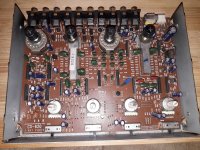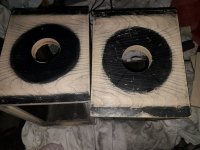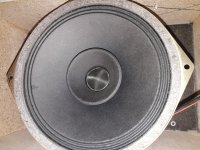I have zero experience with speakers and I want the perfect speaker for me with random drivers in a box...I know how it sounds.
I bought these speakers 5 years ago with all drivers damaged.
Read all the reviews on 780SE.Not enough base...i got it.A passive radiator is said to solve the problem.But the 780 box is trully high quality, heavy dense construction.
The only good speakers I have around are some ITT speakers from some old B&O TV sets (big low mids , small low-mids, tweeters and supertweeters) and the Bose acoustimas 5 subwoofer speakers.
For the small low- mids and supertweeters a different smaller speaker will be placed on top of the 780se boxes . A very good midtweeter will get on the faceplate of the Missions next to the midwoofers.
The first problem I'll be facing will be the base box tuning cause the itt big low mids are bigger than the original 780 speakers but lower power.
You have the ITT speaker datasheet, but that's the only technical data I could get on all speakers and I have no ideea what those specs actually mean...
Then I remembered I read something about some active radiator tunning systems:
https://patents.google.com/patent/US20060067553A1/en
That might solve the fundamental problem of the passive radiator needed to be twice the size of the active driver.Not sure which of the speakers will be the active tunning radiators though.I'd preffer the Bose acoustimas speakers to be the active tuning radiators as I don't really need big powers but we'll see...
So I made some holes in the Mission boxes.
Way more work waiting to be done as I intend to make this system a fully active system based on Class d/t TPA and Tripath chips and a car active crossover made by Panasonic which I think is very smart for the job.
Probably in two weeksI'll be starting to work on that, but I'd like to get all the theoretical help I can get to start it the right way.
I bought these speakers 5 years ago with all drivers damaged.
Read all the reviews on 780SE.Not enough base...i got it.A passive radiator is said to solve the problem.But the 780 box is trully high quality, heavy dense construction.
The only good speakers I have around are some ITT speakers from some old B&O TV sets (big low mids , small low-mids, tweeters and supertweeters) and the Bose acoustimas 5 subwoofer speakers.
For the small low- mids and supertweeters a different smaller speaker will be placed on top of the 780se boxes . A very good midtweeter will get on the faceplate of the Missions next to the midwoofers.
The first problem I'll be facing will be the base box tuning cause the itt big low mids are bigger than the original 780 speakers but lower power.
You have the ITT speaker datasheet, but that's the only technical data I could get on all speakers and I have no ideea what those specs actually mean...
Then I remembered I read something about some active radiator tunning systems:
https://patents.google.com/patent/US20060067553A1/en
That might solve the fundamental problem of the passive radiator needed to be twice the size of the active driver.Not sure which of the speakers will be the active tunning radiators though.I'd preffer the Bose acoustimas speakers to be the active tuning radiators as I don't really need big powers but we'll see...
So I made some holes in the Mission boxes.
Way more work waiting to be done as I intend to make this system a fully active system based on Class d/t TPA and Tripath chips and a car active crossover made by Panasonic which I think is very smart for the job.
Probably in two weeksI'll be starting to work on that, but I'd like to get all the theoretical help I can get to start it the right way.
Attachments
-
 20220822_220050.jpg701.6 KB · Views: 160
20220822_220050.jpg701.6 KB · Views: 160 -
 ccf07032012-00000_159436.jpg359.7 KB · Views: 154
ccf07032012-00000_159436.jpg359.7 KB · Views: 154 -
 20220824_202321.jpg547.2 KB · Views: 166
20220824_202321.jpg547.2 KB · Views: 166 -
 20220824_202256.jpg391.8 KB · Views: 150
20220824_202256.jpg391.8 KB · Views: 150 -
 20220824_202125.jpg552.9 KB · Views: 132
20220824_202125.jpg552.9 KB · Views: 132 -
 20220824_202058.jpg476.5 KB · Views: 127
20220824_202058.jpg476.5 KB · Views: 127 -
 20220824_202037.jpg455.2 KB · Views: 128
20220824_202037.jpg455.2 KB · Views: 128 -
 20220824_202014.jpg550.6 KB · Views: 127
20220824_202014.jpg550.6 KB · Views: 127 -
 20220824_201956.jpg442.4 KB · Views: 119
20220824_201956.jpg442.4 KB · Views: 119 -
 20220822_220234.jpg370.6 KB · Views: 128
20220822_220234.jpg370.6 KB · Views: 128 -
 20220822_220200.jpg375.4 KB · Views: 133
20220822_220200.jpg375.4 KB · Views: 133 -
 20220822_220131.jpg489.9 KB · Views: 136
20220822_220131.jpg489.9 KB · Views: 136
Last edited:
I'm not sure what's the appropriate section this loudpeaker will finally move...
Looking at some of these guy's movies I'm thinking at making a 3 way open baffle system with that small box that will make somerhing like a horn to the Bose speakers cause it looks like a lot less work .I wonder what will the minimum Fs be for the ITT mid woofer if I seal its back holes .Will 150 Hz crossover point between Bose and ITT be ok for a sealed back ITT speaker? Will it go down that much? The Bose woofers are pretty insensitive so damping the more sensitive ITT speakers to reproduce 150hz and up might work, but I'm not entirely sure.I might consider modifying the max limit of the crossover for lows up to 500 Hz but will see...
Looking at some of these guy's movies I'm thinking at making a 3 way open baffle system with that small box that will make somerhing like a horn to the Bose speakers cause it looks like a lot less work .I wonder what will the minimum Fs be for the ITT mid woofer if I seal its back holes .Will 150 Hz crossover point between Bose and ITT be ok for a sealed back ITT speaker? Will it go down that much? The Bose woofers are pretty insensitive so damping the more sensitive ITT speakers to reproduce 150hz and up might work, but I'm not entirely sure.I might consider modifying the max limit of the crossover for lows up to 500 Hz but will see...
Attachments
Could anyone give me a hint to how much volume do i need fot the ITT speaker(its datasheet is available in the first post) to reproduce 150 hz correctly when i introduce the 150hz crossover turning point between it and the Bose subwoofer?
Well I need someone's help to get these speakers done...or I'll just learn everything I need from youtube tutorials in the next 5 years?!
Relax. So far those have made you want an open baffle 3-way, but it seems you've overshot the mark.Well I need someone's help to get these speakers done...or I'll just learn everything I need from youtube tutorials in the next 5 years?!
I want to help but first I need to know what's stopping you. Can you combine the crossover and the natural response and have it agree with the sub? Why not? What equipment/techniques will you use?Could anyone give me a hint to how much volume do i need fot the ITT speaker(its datasheet is available in the first post) to reproduce 150 hz correctly when i introduce the 150hz crossover turning point between it and the Bose subwoofer?
What is this all about?active radiator tunning
I just hope you understand I'm mostly undecided because I never made a speaker in my life, nor I have the necessary theoretical knowledge to do it right.
https://patents.google.com/patent/US20060067553A1/en
but it looks now like I'd go classic if i make an open baffle .That active radiator can simulate an open baffle while creating an isobaric condition to the main speaker though.
For this project I have two mission Cyrrus boxes, two Bose 5.5 inch subwoofers from Acoustimas 5 box(I have no ideea how good they are or their datasheet, but they are stiff and have some damping glued to the cone) , another two 5.5 inch ITT mid-woofers(50 ....10khz) with weaker and thinner suspension and cone for which I attached the complete datasheet and some ITT tweeters.All of them will be driven from class d/t chips and a three way car crossover made by Matsushita.
If I go open baffle for the Bose subwoofer below 150 Hz (that's the max limit that the active crossover will allow me at 12 or 18db/octave), I thought that I'll need to isolate the ITT mid-woofer(50hz....10khz bandwidth) from the main pressure beam of the Bose subwoofer attached under the box as it has much less stiff suspensions and thinner cone than the Bose smaller subwoofer. Thus, if my rationale is correct, I would need to create a small enclosure for the ITT speaker that should still allow it to go down to 150hz limit.I don't know how large that enclosure should be to pass 150hz natturaly.
Woild it be sufficient let's say just to use some stiff duct tape on the back of the ITT speakers and just close its back holes? 150Hz doesn't look like in need for much of an enclosure and in order to have the Bose subwoofers driven in open baffle I suppose their spl will be quite low and probably very easy to allign with the larger exposed cones if the ITT speakers.
Should I run just some tests first and draw some empirical conclusions?
It was mentiond in the patent linked in the first post, where I thought I might have used an active speaker instead of a passive radiator to tune the main woofer,What is this all about?
https://patents.google.com/patent/US20060067553A1/en
but it looks now like I'd go classic if i make an open baffle .That active radiator can simulate an open baffle while creating an isobaric condition to the main speaker though.
For this project I have two mission Cyrrus boxes, two Bose 5.5 inch subwoofers from Acoustimas 5 box(I have no ideea how good they are or their datasheet, but they are stiff and have some damping glued to the cone) , another two 5.5 inch ITT mid-woofers(50 ....10khz) with weaker and thinner suspension and cone for which I attached the complete datasheet and some ITT tweeters.All of them will be driven from class d/t chips and a three way car crossover made by Matsushita.
If I go open baffle for the Bose subwoofer below 150 Hz (that's the max limit that the active crossover will allow me at 12 or 18db/octave), I thought that I'll need to isolate the ITT mid-woofer(50hz....10khz bandwidth) from the main pressure beam of the Bose subwoofer attached under the box as it has much less stiff suspensions and thinner cone than the Bose smaller subwoofer. Thus, if my rationale is correct, I would need to create a small enclosure for the ITT speaker that should still allow it to go down to 150hz limit.I don't know how large that enclosure should be to pass 150hz natturaly.
Woild it be sufficient let's say just to use some stiff duct tape on the back of the ITT speakers and just close its back holes? 150Hz doesn't look like in need for much of an enclosure and in order to have the Bose subwoofers driven in open baffle I suppose their spl will be quite low and probably very easy to allign with the larger exposed cones if the ITT speakers.
Should I run just some tests first and draw some empirical conclusions?
You are starting out with speakers. Maybe you shouldn't let Youtube decide, there is no open conversation there which you can use to decide if it is right.
In my opinion an open baffle is not what you are looking for the first time around. Stay with something conventional. Maybe you can get a used speaker and modify it..
What size? Ok, what data do you have? Would you like to measure? Would you like to try some boxes instead and see what size works best?
In my opinion an open baffle is not what you are looking for the first time around. Stay with something conventional. Maybe you can get a used speaker and modify it..
Try starting with a closed box. You can use equalisation but the idea of an active tuning woofer is probably needlessly elaborate.I thought I might have used an active speaker instead of a passive radiator to tune the main woofer,
What size? Ok, what data do you have? Would you like to measure? Would you like to try some boxes instead and see what size works best?
The material I have is all I can use for now.I know the speakers I have are good speakers .The ITT speakers are from an old but overly expensive B&O tv set.I couldn't use their enclosure as it was part of the huge TV case...The Mission box was made for small 4.5 inch mid woofers working base reflex, thus I naturally supposed they won't be able to give enough volume to the 5.5 inch stiffer and damped Bose subwoofers.I think I saw some people mention the Bose acoustimas subwoofer having both speakers in it was able to take about 250 Watts base reflex...thus I thought that maybe an open baffle 5...10 watts design would keep the Bose speakers alive without tearing their suspentions yet letting them go down to 40hz while putting them in an enclosed box I would probably need three times more volume or just 10 times more power with the actual Mission box size to move them right .
The way they are placed under the mission box make the box some sort of a horn so maybe the sensitivity will be somewhat better than a classical open baffle, at 150 hz we have some directivity....not much though.
The way they are placed under the mission box make the box some sort of a horn so maybe the sensitivity will be somewhat better than a classical open baffle, at 150 hz we have some directivity....not much though.
A 15" driver is borderline enough to go down to 40Hz in dipole while still getting loud enough, after being properly equalised.. so your smaller driver may struggle to keep up. No problems with a closed box. Think about the cancellation.
Ok, so for a closed box there are probably a couple of ways to go which you would choose. Either you measure the electrical impedance while adding mass to the cone to determine the box parameters or you put it in a box and measure the response with a microphone.
Ok, so for a closed box there are probably a couple of ways to go which you would choose. Either you measure the electrical impedance while adding mass to the cone to determine the box parameters or you put it in a box and measure the response with a microphone.
Had once the chance to listen to Tannoy red15 put in 2 meters tall boxes...50's professional monitoring system ...fantastic thing...almost identical frequency response to 3 way Barefoot mm27.A 15" driver is borderline enough to go down to 40Hz in dipole while still getting loud enough, after being properly equalised..
I do what I can....
Just full range...More about'em here:
https://www.diyaudio.com/community/threads/help-with-these-speakers.369774/
https://www.diyaudio.com/community/threads/help-with-these-speakers.369774/
Nice, this is a good place to start learning about boxes.
Know that the outside of the box is important too. I like the effect of a larger front for the speaker when it is done well, but this is something for you to decide.
Know that the outside of the box is important too. I like the effect of a larger front for the speaker when it is done well, but this is something for you to decide.
I listened to them in the original Dual cl 9 enclosures and they weren't bad, but they do need some more base extension through pasive means as mids are just ok.I won't comment about the highs cause at 45 yo I can't be bothered about the silky highs, maybe some more IMD would contribute artificially to highs extension 🙂
Being 4 ohms max 10 watt speakers I think my germanium amplifiers or the Tripath ta2024 supplied at 12 V should be ideal.
Being 4 ohms max 10 watt speakers I think my germanium amplifiers or the Tripath ta2024 supplied at 12 V should be ideal.
Looking at these videos and considering the space I live in...Voight speakers seem to be out of question...I need to get rich first and buy a large house for them 🙂
For the wiewers patience sake I'll just try two sealed speakers one on top of the other put on their sides to keep the speakers as close as possible.The Bose with the sealed Mission boxes and the Dual CL 9 speakers with more damping material inside for mid highs.If needed....possibly add a tweeter later and that's all for now.
Maybe I'll try a passive or active radiator for the Bose, but that remains to be seen.
Maybe I'll try a passive or active radiator for the Bose, but that remains to be seen.
- Home
- Loudspeakers
- Multi-Way
- Bear with me..modified Mission 780se





